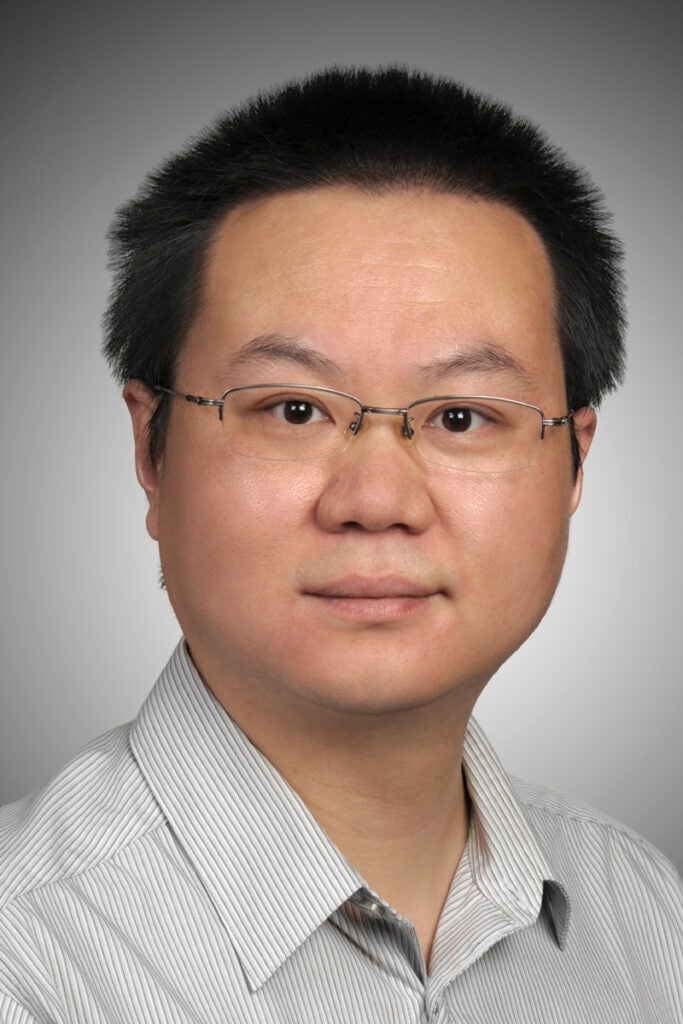
Gang Chen, Ph.D.
Biochemistry, Chemistry & Physics
Home Campus: Statesboro
gchen@georgiasouthern.edu
912-478-7350
Research Areas
Plasmonic Nanomaterials, Energy Saving Materials, Photocatalysis, Biosensor
Education
B.S., Zhengzhou University
Ph.D., Lanzhou Institute of Chemical Physics, Chinese Academy of Sciences
Publications
- Unraveling the thermal evolution of TiO₂-supported Au@ M (M= Ag, Pd, Pt) nanobipyramids: impacts of shell composition on structural and plasmonic stability, Egan, T.; Ren, Z., Feng, X.; Chen, G.*, Nano Research 2025, 18, 94907511.
- Programmable Self-assembly of Colloidal Nanoparticles into Precise Discrete Nanoarchitectures, Molligoda, B.; Egan, T; Chen, G.*, World Scientific Reference on Plasmonic Nanomaterials, Volume 3: Self-Assembly of Plasmonic Nanostructures, May 2022, 239-299.
- pH-mediated Synthesis of Monodisperse Gold Nanorods with Quantitative Yield and Molecular Level Insight, Gallagher, R.; Zhang, X.; Altomare, A.; Lawrence, D. Jr.; Shawver, N.; Tran, N.; Beazley, M.*; Chen, G.*, Nano Research 2021, 14, 1167.
- Ultrasensitive Visual Detection of Glucose in Urine Based on the Iodide-Promoted Etching of Gold Bipyramids, Zhang, X.; Sucre-Rosales, E.; Byram, A.; Hernandez, F. E.*; Chen, G.*, ACS Appl. Mater. Interfaces 2020, 12, 49502.
- Branched Kissing Loops for the Construction of Diverse RNA Homooligomeric Nanostructures, Liu, D.; Geary, C. W.; Chen, G.; Shao, Y.; Li, M.; Mao, C.; Anderson, E. S.; Piccirilli, J. A.; Rothemund, P. W. K.; Weizmann, Y., Nat. Chem. 2020, 12, 249.
- Regioselective Surface Encoding of Nanoparticles for Programmable Self-Assembly, Chen, G.; Gibson, K.; Liu, D.; Rees, H. C.; Lee, J. H.; Xia, W. W.; Lin, R. Q.; Xin, H. L.; Gang, O.; Weizmann, Y., Nat. Mater. 2019, 18, 169.
Funding
Current Grants
- NSF LEAPS-MPS: Investigation of polyaniline-induced plasmon switching on gold nanocrystals and its application for smart windows/mirrors, 8/2023-9/2026, $249,957, PI.
- GSU FRC: Developing a Magnetic Nanoparticle-Assisted ELISA (nELISA) for Selectively Quantitating Trace Amounts of Forever Chemicals (PFAS) in Water, 7/2025-5/2026, $10,000, co-PI.
- GSU COSM CGI: Microstructure-Engineered VO2 for Advanced Thermochromic Smart Windows, 10/2025-9/2026, $11,000, co-PI.
Research Projects
Plasmonic Nanoparticles/polymer Composites for Sustainable Energy
Smart windows, which can dynamically adjust their transmittance or reflectance in response to external stimuli such as electric current, offer a powerful approach to enhancing indoor comfort and security while significantly reducing the energy consumption of air conditioning in buildings and vehicles. Electrochromism-based polymers are promising materials for such applications due to their high processability and compatibility with various substrates. However, their widespread use is limited by poor long-term cycling stability and low color contrast, which arise from material degradation under high electrochemical potentials. To address this challenge, we are exploring the integration of plasmonic nanoparticles with electrochromic polymers. By leveraging their tunable optical properties, we aim to achieve high color contrast at relatively low operating potentials, thereby minimizing electrochemical deterioration of the polymer. This strategy could enable active plasmonic color switching, opening new possibilities in applications such as information displays, anti-counterfeiting inks, and pH-responsive photothermal systems for cancer therapy.
High Entropy Alloy Nanoparticles (HEA NPs) for Catalysis and Biomedical Applications
HEA NPs have emerged as a promising new class of electrochemical catalysts. Comprising five or more principal elements in near-equimolar ratios, HEAs offer exceptional compositional flexibility, enabling tunable electronic structures, abundant active sites, and synergistic effects that enhance nitrogen activation while suppressing the Hydrogen evolution reaction. However, current synthetic approaches to HEA NPs often require harsh conditions and struggle to precisely control particle size, shape, and surface facets, key parameters governing catalytic activity. These challenges have limited their broader application in electrocatalytic ammonia synthesis. This project aims to address these limitations by developing epitaxial growth strategies to synthesize HEA NPs with well-controlled size, shape, and surface facets. This will allow us to systematically investigate how these structural parameters influence catalytic performance and to design highly efficient catalysts for electrochemical ammonia production. Moreover, the unique catalytic properties of these HEA nanostructures could also enable their use in biomedical applications, such as mimicking the catalytic functions of natural enzymes.
Plasmonic Photocatalysis
Over the past two decades, research efforts to develop renewable energy sources have intensified in response to the global energy crisis. Solar energy stands out as an abundant and sustainable option because the amount of solar energy reaching Earth’s surface in just ninety minutes equals the planet’s total annual energy consumption. To harness this vast resource for practical applications, technologies must be developed to efficiently harvest and convert solar energy into usable forms. Photocatalysts offer a promising route by converting light energy into chemical energy to drive surface reactions. While most research has focused on semiconducting photocatalysts, which operate by generating electron-hole pairs through interband excitation, plasmonic NPs have recently gained significant attention for their large optical cross-sections and strong localized electromagnetic field enhancement. Building on our extensive expertise in synthesizing plasmonic NPs, our group aims to develop plasmonic photocatalysts by depositing catalytic metal shells onto plasmonic cores. By tailoring the shell composition and thickness, these core-shell photocatalysts can be engineered to achieve enhanced catalytic activity and selectivity for key solar-driven chemical transformations, such as the nitrogen reduction reaction (NRR) and the carbon dioxide reduction reaction (CO₂RR).
News
- Zach Murphy joined our group as a research assistant. Wellcome, Zach!
- Dr. Chen received the Georgia Southern COSM Collaborative Grant Initiative grant as a co-PI. Congratulations to the team!
- Dr. Yiteng Tang joined our group as a postdoc and will work on the HEA-related projects. Welcome on board, Yiteng!
- Kaleah Mccall, an undergraduate researcher, participated in the REU program at Mississippi State University this summer.
- Dr. Chen received the Georgia Southern FRC research grant as a co-PI. Congratulations to the team!
- Our research work on plasmonic photocatalyst has been published in Nano Research. Congratulations to Thomas, Zhuanghe, and Xiaofeng!
- Dr. Chen participated in a spectroscopy education workshop at Mississippi State University. Lots of fun!
- Dr. Chen attended the ACS Spring 2025 National Meeting in San Diego and gave a talk on a colorimetric sensor based on one-dimensional Au NPs.
- Dr. Chen gave a seminar in the Chemistry Department at Mississippi State University. Thanks a lot for the invitation from Dr. Dongmao Zhang.
- Laila Robinson and Elisa Smith joined our group as Emerging Researchers. Thanks for the support from the COSM COUR program!
Research Group
Undergraduate Students
Laila Robinson, Elisa Smith, Kaleah Mccall, Zach Murphy
Graduate Students
- Thomas Egan
Postdocs
- Dr. Yiteng Tang
